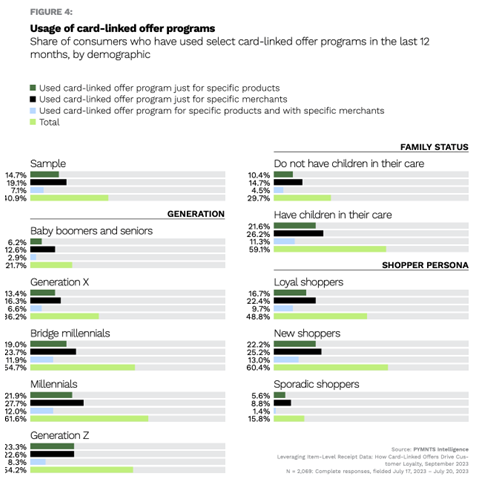Gen Z Favors Brands vs Retailers for Card-Linked Offers

Retailers and brands are constantly seeking ways to foster customer loyalty and generate new sources of sales. One effective strategy is to leverage item-level receipt data to provide personalized and relevant card-linked offers. These programs provide economic incentives, such as cash-back rewards, which increase customer loyalty. Market research indicates that rewards programs play a significant role in consumer shopping decisions. Around two-thirds of credit or debit card users prefer to shop with brands or merchants where they are members of loyalty or rewards programs. Between the two, typically, consumers from all age groups prefer to turn to merchants (i.e. clothing or grocery retailers) for card-linked offers rather than to specific products (i.e. beauty brands). Gen Zers are an exception to this trend, being the only group that turns more to card-linked offers related to brands.
These are some of the key insights found in “Leveraging Item-Level Receipt Data: How Card-Linked Offers Drive Customer Loyalty,” a PYMNTS-Banyan research study that surveyed more than 2,000 consumers in the U.S. to understand their interest in loyalty and rewards programs, their preference for card-linked offers, and how merchants can increase awareness and usage of these offers.

According to the research, 23% of Gen Zers used a card-linked offer program for specific products in the last 12 months, and 22% used it for merchants. The gap between the two is not very important, but what is remarkable is that, among all age groups, Gen Z is the only one that uses more card-links offers for products.
Although only 13% of loyal shoppers and 19% of new customers are Gen Z, as reported by the study, they represent a potential target for long-term relationships with brands. By offering personalized rewards and relevant card-linked offers, brands can attract and engage Gen Z consumers, driving loyalty and increasing sales.
Saturday skin, a personal care brand, is following this strategy. In their Amazon’s direct-to-customer website, a loyalty program is in place, and the brand uses direct messages to remind members about promotions and foster a connection. In addition, the brand is exploring the potential of a card holders program by offering promotions and discounts linked to regular intervals, encouraging customers to subscribe and regularly use products like cleansing gel.
Card-linked offers provide a win-win solution for both merchants and consumers, creating a seamless shopping experience in many cases. To unlock the full potential of these programs, brands and card issuers must promote them, educating consumers about their benefits and how they work. In the case of digital-savvy Generation Z, this implies a multi-channel approach through social media, email or other online channels.